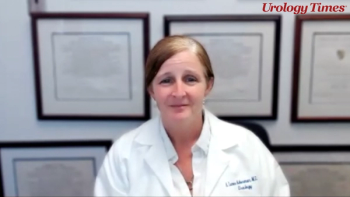
Dr. Fisher highlights factors influencing fall risk among women with pelvic floor disorders
"About 30% of women screened positive, but of course when we looked at [the data] stratified by age, about 50% of women 65 years and older had a positive screen," says Steven R. Fisher, PhD, PT, GCS.
In this video, Steven R. Fisher, PhD, PT, GCS, highlights the findings and importance of the study, “Cumulative Effects of Comorbid Burden and Overactive Bladder Symptoms on Fall Risk Among Older Women Seeking Treatment for Urogynecologic Conditions,” for which he served as the lead author. Fisher is a professor in the department of physical therapy at the University of Texas Medical Branch in Galveston, Texas.
Video Transcript:
Slide 1:
There's a large body of evidence linking urinary incontinence, and specifically urgency urinary incontinence, and OAB symptoms with falls in older adults. In studies that use multivariate models to identify predictors of falling in older people, urinary incontinence is always right there in the top of the field. What was less known was the actual prevalence of high fall risk among treatment-seeking women with pelvic floor disorders. So, our objectives with this study, broadly, were 1, to estimate the prevalence of high fall risk among this specific patient population, and 2, because fall risk factors are cumulative – in other words, because the more risk factors that a person has the higher her risk of falls – we wanted to also investigate the cumulative effects of other known risk factors on fall risk in this patient population.
For this study, we looked at easily derivable in the busy clinic factors, so that was OAB symptom burden, other comorbid health condition burden, and age. To do that, the CDC's, 3 key questions fall risk screening tool was included within the intake forms that all patients fill out when they're waiting to see their doctor at one of our outpatient pelvic health centers here at UTMB. We were able to have this relatively large cohort of patients with a valid fall screen and then go into the electronic medical record and extract other sociodemographic and clinical characteristics and look at these different patient profiles in terms of fall risk or likelihood of screening positive on the 3 key questions screening tool.
Slide 2:
One of the surprising was the actual prevalence across age groups, about 30% of women screened positive, but of course when we looked at [the data] stratified by age, about 50% of women 65 years and older had a positive screen. Then when we looked at those combined effects or cumulative effects of these 3 characteristics: 65 years and older, 3 or more OAB symptoms, 4 or more comorbid conditions, the odds of screening positive, were about 6-fold higher in women with that particular profile compared to women who didn't have that combination of factors. So, about 3 in 4 actually screened positive if they had those characteristics.
This transcription has been edited for clarity.
Newsletter
Stay current with the latest urology news and practice-changing insights — sign up now for the essential updates every urologist needs.


















